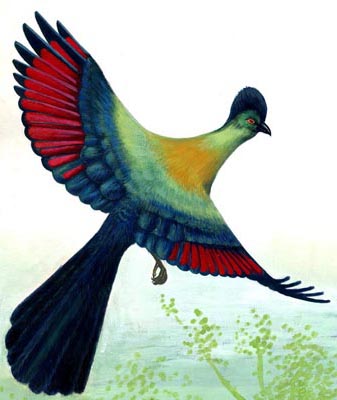The ENTC now has a new website, at www.entc.org.sz
Our logo is adapted from a painting by Phillip Dlamini, 1998, of a purple crested turaco. In traditional Swazi dress, the red feathers feature in the royal headdress, so this bird illustration is not only a symbol for wildlife conservation, but also of cultural heritage.


Early Stone Age handaxes are commonly found in Eswatini along the banks of rivers. These are stylistically similar to tools found in the African Rift valley where dates for hominid evolution have been obtained. We may assume that the tools in Eswatini are of broadly similar dates, making the earliest hominids here at around 2 to 1.5 million years ago. There are no fossils in Eswatini because the country lacks the limestone rocks necessary for fossil formation.
The Middle Stone Age (MSA) is believed to have started around 200 000 to 150 000 years ago with the emergence of physically modern humans. MSA tools are widely distributed in Eswatini. Excavations at Lion and Castle caverns at Ngwenya Mine have provided dates extending back to 43 000 years ago in the later phases of the MSA. These caverns were in fact mines that were used to extract specularite (glitter) and haematite (brown-red ochre used in paintings and for rituals).
(Updated by Bob Forrester, December 2005)
The SARA research team obtained dates from excavating the Siphiso and Nyonyane shelters. Siphiso was occupied from around 13 500 years ago to 350 years ago and Nyonyane from 11 000 to 3200 years ago. Both shelters were unoccupied for a 4000 to 5000 year gap during a cold climatic phase when people moved to the warmer coastal plains. These dates fall well within the Late Stone Age (LSA) which dates back 25 to 30 000 years ago in Eswatini. This was a period when ancestral San / Bushmen were the sole occupants of the country.
The rock paintings in the country are believed to date from the LSA after people moved back into Eswatini as the climate warmed up again 3000 years ago. It is unlikely that any of the painted figures are older than this because the highvelt region, where paintings are most common, is also extremely wet in summer. Water and fungus degrade paintings rapidly.
People migrated down Africa and reached Eswatini in about around 400 to 450 AD. They brought with them agriculture, domestic animals and iron smelting. This culture is known as Silverleaves from its pottery, however it is not known what language they spoke or to which cultural group they belonged. It is thought that by 1400 AD Sotho speaking peoples had settled in Eswatini and that the Nguni speaking peoples entered the country in the 1700s with the arrival of the Dlamini clan and their followers from the coastal plains of Mozambique near Maputo. In the early 1800s there was a severe drought and starvation caused widespread social disruption in south-east Africa - this period is known as the Mfecane. The aggressive Zulu military kingdom grew out of this disorder and its expansion threatened the independent clans living in Eswatini. The clans grouped together under the leadership of the Dlamini to repulse the Zulu threat and in the process formed a nation and a country - Swaziland, known as Eswatini as of 2018.
Our Contacts:
Head Quarters: (+268) 2416 1489/1179
Email: info@sntc.org.sz
King Sobhuza II Park: (+268) 2416 1489/1179
Email: ksmp@sntc.org.sz
National Museum: (+268) 2416 1489/1179
Email: curator@sntc.org.sz
Copyright © ESWATINI NATIONAL TRUST COMMISSION
Malolotja Nature Reserve: (+268) 2444 3241 / (+268) 2416 1480
Email: culturalvillage@sntc.org.sz
Mantenga Nature Reserve and Swati Cultural Village: 2416 1151/1178
Email: culturalvillage@sntc.org.sz
Mlawula Nature Reserve: (+268) 2383 8885 (Reception)
(+268) 2383 8453 (Senior Warden)
Email: culturalvillage@sntc.org.sz
Magadzavane Lodge: (+268) 2343 5108/9
Email: magadzavane@sntc.org.sz